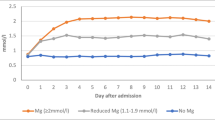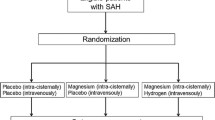Abstract
Introduction: Recent evidence suggests that magnesium may be neuroprotective in the setting of cerebral ischemia, and therapeutic magnesium infusion has been proposed for prophylaxis and treatment of delayed ischemic neurological deficit (DIND) resulting from vasospasm in patients with aneurysmal subarachnoid hemorrhage (SAH). We studied the association between serum magnesium levels, the development of DIND, and the outcomes of patients with SAH.
Methods: We studied 128 consecutive patients with aneurysmal SAH treated at our institution between 1990 and 1997 who had a serum magnesium level measured at least once during the acute phase of their hospitalization. Delayed ischemic neurological deficit was defined as severe (major focal deficit or coma), moderate (incomplete focal deficit or decreased sensorium without coma), or none.
Results: There was no significant difference in mean, minimum, or maximum serum magnesium levels between patients with and without DIND (1.93, 1.83, 2.02 versus 1.91, 1.84, 1.97 mg/dL, respectively). Similarly, no difference was found in mean serum magnesium levels among patients with severe (1.94 mg/dL), moderate (1.92 mg/dL), or no DIND (1.91 mg/dL). Analyses of serum magnesium levels before (0–4 days following SAH), during (4–14 days following SAH), and after (greater than 14 days following SAH) the period of highest risk for vasospasm revealed no association with the development or severity of DIND. Permanent deficit or death resulting from vasospasm and Glasgow Outcome Scale score at longest follow-up were similarly unaffected by serum magnesium levels overall or during any time interval. Forty (31.5%) patients were hypomagnesemic (less than 1.7 mg/dL) during hospitalization, but no difference in outcome (p=0.185) or development of DIND (p=0.785) was found when compared to patients with normal (1.7–2.1 mg/dL) or high (greater than 2.1 mg/dL) magnesium serum levels.
Conclusion: We identified no relationship between serum magnesium levels and the development of DIND or outcome following aneurysmal SAH. Based on these data, magnesium supplementation to normal or high-normal physiological ranges seems unlikely to be beneficial for DIND resulting from vasospasm. However, no inference can be made regarding the value of therapeutic infusion of magnesium to supraphysiological levels.
Similar content being viewed by others
References
Kassell NF, Sasaki T, Colohan ART, Nazar G. Cerebral vasospasm following aneurysmal subarachnoid hemorrhage. Stroke 1985;16:562–572.
Macdonald RL, Weir B. Cerebral vasospasm: prevention and treatment. In: Cerebrovascular disease. (Batjer H, ed.). Lippincott-Raven, Philadelphia, 1997, 1111–1121.
Allen GS, Ahn HS, Preziosi TJ, et al. Cerebral arterial spasm—a controlled trial of nimodipine in patients with subarachnoid hemorrhage. N Engl J Med 1983;308:619–624.
Boisvert DP, Hundley MB, Johnson RK, Strom JA, Transou CR. Cerebral arterial spasm, a controlled trial of nimodipine in patients with subarachnoid hemorrhage. N Engl J Med 1983;308:619–624.
Elliott JP, Newell DW, Lam DJ, et al. Comparaison of balloon angioplasty and papaverine infusion for the treatment of vasospasm following aneurysmal subarachnoid hemorrhage. J Neurosurg 1998;88:277–284.
Haley ECH, Kassel NF, Torner JC. The international cooperative study on the timing of aneurysm surgery: the North American experience. Stroke 1992;23:205–214.
Haley ECH, Kassell NF, Torner JC. A randomized controlled trial of high-dose intravenous nicardipine in aneurysmal subarachnoid hemorrhage: a report of the Cooperative Aneurysm Study. J Neurosurg 1993;78:537–547.
Takaku A, Tamaka S, Mori T, Susuki J. Postoperative complications in 1000 cases of intracranial anevrysms. Surg Neurol 1979;12:137–144.
Ram Z, Sadeh M, Shacked I, Sahar A, Hadani M. Magnesium sulphate reverses experimental delayed cerebral vasospasm after SAH in rats. Stroke 1991; 22:922–927.
Altura BM, Altura BT. Magnesium and contraction of arterial smooth muscle. Microvasc Res 1974;7:145–155.
Altura BT, Altura BM. Withdrawal of magnesium causes vasospasm while elevated magnesium produces relaxation of vascular tone in cerebral arteries. Neurosci Lett 1980;20:323–327.
Altura BM, Altura BT. Magnesium and contraction of vascular smooth muscles: Relationship to some vascular diseases. Fed Proc 1981;40:2672–2679.
Altura BT, Altura BM. The role of magnesium in etiology of strokes and cerebrovasospasm. Magnesium 1982;1:277–291.
Ema M, Gebrewold A, Altura BT, Altura BM. Magnesium sulfate prevents alcohol-induced spasms of cerebral blood vessels: an in situ study on the brain microcirculation from male versus female rats. Magnes Trace Elem 1991;10:269–280.
Iseri LT, French JH. Magnesium: nature’s physiologic calcium blocker. Am Heart J 1984;108:188–193.
Vink R, Mc Intosh TK. Pharmacological and physiological effects of magnesium on experimental traumatic brain injury. Magnes Res 1990;3:163–169.
Vink R, McIntosh TK, Romhanyi R, Faden AI. Opiate antagonist nalfemene improves intracellular free magnesium bioenergetic state and neurological outcome following traumatic brain injury in rats. J Neurosci. 1990;10:3524–3530.
Farber JL, Chien KR. The pathogenesis of irreversible cell injury in ischemia. Am J Pathol 1981;102:271–281.
Izumi Y, Roussel S, Pinard E, Seylaz J. Reduction of infarct volume by magnesium after middle cerebral artery occlusion in rats. J Cereb Blood Flow Metab 1991;11:1025–1030.
Kass IS, Cottrel JE, Chambers G. Magnesium and cobalt, not nimodipine protect neurons against anoxic damage in the rat hippocampal slice. Anesthesiology 1988;69:710–715.
Marinov M, Harbaugh KS, Hoopes PJ, Pikus HJ, Harbaugh RE. Neuroprotective effects of preischemia intraarterial magnesium sulfate in reversible focal cerebral ischemia. J Neurosurg 1996;85:117–124.
McIntosh TK, Vink R, Yamakami I, Faden AI. Magnesium protects against neurological deficit after brain injury. Brain Res 1989;482:252–260.
Rehncrona S, Westerberg E, Akesson B, Siesjo BJ. Brain cortical fatty acids and phospholipids during and following complete and severe incomplete ischemia. J Neurochem 1982;38:84–93.
Vacanti FX, Ames A III. Mild hypothermia and magnesium protect against irreversible damage during CNS ischemia. Stroke 1984;15:695–698.
Woodruff GN, Foster AC, Gill R, Kemp JA, Wong EH, Iversen LL. The interaction between MK-801 and receptors for N-methyl-d-aspartate: functional consequences. Neuropharmacology 1987;26:903–909.
Cheung JY, Bonventre JV, Malis CD, Leaf A. Calcium and ischemic injury. N Engl J Med 1986;314:1670–1676.
Goldman RS, Finkbeiner SM. Therapeutic use of magnesium sulfate in selected cases of cerebral ischemia and seizure. N Engl J Med 1988; 319:1224–1225.
Mayer ML, Westerbrook GL, Guthrie PB. Voltage-dependent block by magnesium of NMDA responses in spinal cord neurones. Nature (Letter) 1984;309:261–263.
Meldrum BS, Evans MC, Swan JH, Simon RP. Protection against hypoxic/ischemic brain damage with excitatory amino acid antagonists. Med Biol (review) 1987;65:153–157.
Nowak L, Bregestovski P, Ascher P. Magnesium gates glutamate-acivated channels in mouse central neurones. Nature (Letter) 1984;307:462–465.
Priestley T, Horne AL, Mc Kernan RM, Kemp JA. The effect of NMDA receptor glycine site antagonist on hypoxia-induced neurodegeneration of rat cortical cell culture. Brain Res 1990;531:183–188.
Rothman S. Synaptic activity mediates death of hypoxic neurones. Science 1983;220:536–537.
Rothman SM, Olney JW. Excitotoxicity and the NMDA receptor. Trends Neurol Sci 1987;10:299–302.
Anthony J, Johanson R, Dommisse J. Critical Care Management of severe pre-eclampsia. Fet Mat Med Rev 1994;6:219–229.
Anthony J, Johanson RB, Duley L. Role of magnesium sulfate in seizure prevention in patients with eclampsia and pre-eclampsia. Drug Safety 1996;15:188–199.
McLean RM. Magnesium and its therapeutic uses: a review. Am J Med 1994;96:63–76.
Pritchard JA, Pritchard SA. Standardized treatment of 154 consecutive cases of eclampsia. Am J Obstet Gynecol 1975;123:543–552.
Sabai GM, Anderson GD. Eclampsia. In: Neurological disorder of pregnancy. (Goldstein P, ed.). Futura Publishing, Mount Kisco, 1986, 1–18.
Sadeh M. Action of magnesium sulfate in the treatment of preeclampsia-eclampsia. Stroke 1989;20:1273–1275.
Watson KV, Moldow CF, Ogburn PL, Jacob HS. Magnesium sulfate: rationale for its use in preeclampsia. Proc Natl Acad Sci USA 1986;83:1075–1078.
Evans S, Frigoletto F, Jewett JF. Mortality of eclampsia; a case report and the experience of the Massachusetts maternal mortality study, 1954–1982. N Engl J Med 1984;309:1644–1647.
Will AD, Lewis KL, Hinshaw DB, et al. Cerebral vasoconstriction in toxemia. Neurology 1987;37:1555–1557.
Lewis KL, Hinshaw DB, Will AD, Hasso AN, Thompson JR. CT and angiographic correlations of severe neurological disease in toxemia of pregnancy. Neuroradiology 1988;30:59–64.
Beck RW, Menezes AH. Intracerebral hemorrage in a patient with eclampsia. JAMA 1981;246:1442–1443.
Trommer BL, Homer D, Mikhael MA. Cerebral vasospasm and eclampsia. Stroke 1988;19:326–329.
Belfort MA, Moise KJ. Effect on magnesium sulfate on maternal brain blood flow in preeclampsia: a randomized, placebo-controlled study. Am J Obstet Gynecol 1992;167:661–666.
Boet R, Mee E. Magnesium Sulfate in the management of patients with Fisher grade 3 subarachnoid hemorrhage: a pilot study. Neurosurgery 2000;47:602–607.
Veyna RS, Seyfried D, Burke D, et al. Magnesium sulfate therapy after aneurysmal subarachnoid hemorrhage. J Neurosurg 2002;96:510–514.
Ryzen E, Wagers PW, Singer FR, Rude RK. Magnesium deficiency in a medical ICU population. Crit Care Med 1985;13:19–21.
Memon ZI, Altura BT, Benjamin JL, Cracco RQ, Altura BM. Predictive value of serum ionized but not total magnesium levels in head injurie. Scand J Clin Lab Invest 1995;55:671–677.
Altura BT, Memon Z, Zhang A, et al. Low levels of serum ionized magnesium found in stroke patients result in rapid elevation in cytosolic free calcium and spasm in cerebral vascular muscle cells. Neurosci Lett 1997;230:37–40.
Moncada S, Vane JR. Arachidonic acid metabolites and the interactions between platelets and blood-vessel walls. N Engl J Med 1979;300:1142–1147.
Vink R, McIntosh TK, Demediuk P, Weiner W, Faden AI. Decline in intracellular free magnesium concentration is associated with irreversible tissue injury following brain trauma. J Biol Chem 1988;263:757–761.
McIntosh TK, Smith DH, Meaney DF, Kotapka MJ, Gennarelli TA, Graham DI. Neuropathological sequelae of traumatic brain injury: relationship to neurochemical and biochemical mechanism. Lab Invest 1996;74:315–342.
Williams GD, Smith MB. Application of the accurate assessment of intracellular magnesium and pH from the P-31 shifts of ATP to cerebral hypoxia-ischemia in neonatal rat. Magn Reson Med 1995;33:853–857.
Helpern JA, Van De Linde AMQ, Welch. KMA, et al. Acute elevation and recovery of intracellular magnesium following human focal cerebral ischemia. Neurology 1993;43:1577–1581.
Mullins PGM, Vink R. Chronic alcohol exposure decreases brain intracellular free magnesium concentration in rats. Neuroreport 1995;6:1633–1636.
Altura BM, Altura BT. Role of magnesium and calcium in alcohol-induced hypertension and stroke as probed by in vivo television microscopy, digital image microscopy, optical spectroscopy, 31P-NMR spectroscopy, and a unique magnesium ion-selective electrode. Alcohol Clin Exp Res 1994;18:1057–1068.
Altura BM, Gupta RK. Cocaine induces intracellular free magnesium deficits, ischemia and stroke as observed by in-vivo 31P NMR of the brain. Biochim Biophys Acta 1992;1111:271–274.
Feldman Z, Gurevitch B, Artru AA, Oppenheim A, Shohami E, Reichenthal E, Shapira Y. Effect of magnesium given 1 hour after head trauma on brain edema and neurological outcome. J Neurosurg 1996;85:131–137.
Vink R, Heath DL, McIntosh TK. Acute and prolonged alterations in brain free magnesium following fluid percussion-induced brain trauma in rats. J Neurochem 1996;66:2477–2483.
McIntosh TK, Faden AI, Yamakami I, Vink R. Magnesium deficiency exacerbates and pretreatment improves outcome following traumatic brain injury in rats: 31P magnetic resonance spectroscopy and behavioral studies. J Neurotrauma 1988;5:17–31.
Ewlin RJ. Magnesium metabolism in health and disease. Dis Month 1988;34:165–218.
Oppelt WW, Macintyre I, Rall DP. Magnesium exchange between blood and cerebrospinal fluid. Am J Physiol 1963;205:959–962.
Bito L. Blood brain barrier, evidence for acute cation transport between blood and the extracellular fluid of brain. Science 1969;165:81–83.
Gee JB, Corbett RJT, Perlman JM, Laptook AR. Hypermagnesemia does not increase brain intracellular magnesium in newborn swine. Pediatr Neurol 2001;25:304–308.
Brewer RP, Parra A, Borel CO, Hopkins MB, Reynolds JD. Intravenous magnesium sulfate does not increase ventricular CSF ionized magnesium concentration of patients with intracranial hypertension. Clin Neuropharmacol 2001;24:341–345.
Hallak M, Berman RF, Irtenkauf SM, Evans MI, Cotton DB. Peripheral magnesium sulfate enters the brain and increases the treshold for hippocampal seizure in rats. Am J Obstet Gynecol 1992;167:1605–1610.
Kim YJ, Mc Farlane C, Warner DS, Baker MT, Choi WW, Dexter F. The effect of plasma and brain magnesium concentration on lidocaine-induced seizure in rats. Anesth Analg 1996;83: 1223–1228.
Author information
Authors and Affiliations
Corresponding author
Rights and permissions
About this article
Cite this article
Collignon, F.P., Friedman, J.A., Piepgras, D.G. et al. Serum magnesium levels as related to symptomatic vasospasm and outcome following aneurysmal subarachnoid hemorrhage. Neurocrit Care 1, 441–448 (2004). https://doi.org/10.1385/NCC:1:4:441
Issue Date:
DOI: https://doi.org/10.1385/NCC:1:4:441




